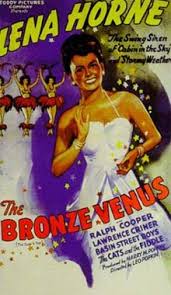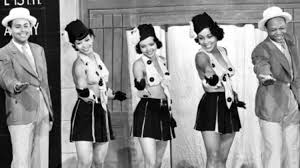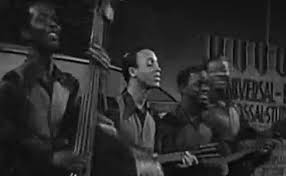An Essential Film in Black History: The Duke Is Tops (1938)
The Duke Is Tops (1938) is an American musical film released by Million Dollar Productions, a production company noted for advancing Black filmmaking in the late 1930s. Ralph Cooper, one of the three heads of Million Dollar Productions, scripted, co-directed and starred in the film.
The Duke Is Tops is a B-musical featuring a mostly all-Black cast. In film history, it is considered a “race film” due to its casting as a vehicle for Black performers and its target market of Black filmgoers. Reportedly made in only ten days, none of the cast members were paid for their work as Ralph Cooper ran out of money during production. This included then 20-year-old Lena Horne who made her first film performance in The Duke Is Tops. Horne is given top billing in the movie credits and stars as leading lady opposite Cooper.
Ralph Cooper is best remembered as the original master of ceremonies and founder in 1935 of amateur night at the Apollo Theater in Harlem, New York City, a role he passed on to his son in 1986. A consummate promoter of Black entertainers, Cooper wrote, produced, directed, and acted in 10 films for Million Dollar Productions, casting in his films many of the best variety act performers of the day.
The plot of The Duke Is Tops reflects what Cooper himself knew of the entertainment business in the 1930s. No longer in its heyday, Vaudeville was on the decline and acts of the prior decades found themselves struggling to perform in theaters, nightclubs and sideshow circuits, eking out a living by traveling from town to town.
Cooper plays Duke Davis a stage-show promoter in love with Ethel Andrews played by Lena Horne. Ethel is a popular singer in Duke’s variety act touring the South. The show is visited by big-time promoters from New York who want to contract with Ethel, known as “the Bronze Venus.” Standing in the way is Ethel’s contract with Duke. Ever loyal, she refuses to leave the small-time performing circuit until Duke fakes a lucrative buyout of her contract to propel her to pursue her career without him. As Ethel makes her way to the big city believing her star is on the rise, Duke’s fortune changes. Soon he’s working on a medicine sideshow circuit, peddling cures and entertaining passersby with down-on-their-luck variety acts.
Before long, Duke learns that Ethel’s show in New York is a flop. The girl everyone hoped would be a star is only viewed as a “specialty act.” Duke travels to New York and creates a new show for Ethel to star in to return their good fortune in a top nightclub act.
The Duke Is Tops storyline mirrors the truth of the entertainment industry for Black performers—one evidenced in Lena Horne’s own career. Like her character Ethel, she appeared as a specialty act for years, with walk-on singing parts in films from 1942-1956.
In 1943, bolstered by several film appearances and a long booking at the Savoy-Plaza Hotel, Horne achieved the spotlight and was signed to a seven-year contract with MGM. The Duke Is Tops was re-released the same year under a new title—The Bronze Venus—to capitalize on her fame.
Other than larger appearances in Cabin in the Sky and Stormy Weather, both released in 1943, most of Horne’s film appearances were standalone sequences with no relation to the film’s storyline where she would perform a single song. Ensuring these sequences were not essential to the plot, this allowed filmmakers to edit Horne’s performances out of the films so they could be shown in theaters that would not show films with Black performers. Indeed, just as Ethel is labeled a specialty act in The Duke Is Tops, Horne was treated as a specialty act throughout her remaining film career.
The Duke Is Tops is essential viewing as the only film featuring Lena Horne in a leading role. It is equally important as a chronicle of what life was like for Black performers. As a film about the entertainment business through the work of a variety show producer, it includes within it a variety show on par with other films of the times. One could say that The Duke Is Tops serves as a specialty act showcase. Through the various Duke-produced shows in the film, a variety of talented acts are featured. The Duke Is Tops presents a unique opportunity to see the performances of these Black artists captured on film.
William McKinley “Willie” Covan—Willie Covan began performing on Vaudeville at the age of six. Later he was a member of the tap quartet The Four Covans, and in 1922 the act appeared in the historic all-black Broadway musical show, Miller and Lyle’s Shuffle Along. The great tap dancer Eleanor Powell insisted he become the head dance instructor at MGM studios where he worked with screen stars ranging from Shirley Temple and Mickey Rooney to Ann Miller.
Basin Street Boys—In the 1930s and 1940s two singing groups using the name Basin Street Boys were performing as vocal and instrumental groups. The group appearing in The Duke Is Tops was originally known as the 4 Dots. In the mid-1930s they appeared on the radio, in nightclubs and in select films singing a mixture of pop, jazz, ballads and blues.
Rubberneck Holmes— Rubberneck Holmes was a soft shoe tap dancer known for combining tap, acrobatics, jazz dance, and an eccentric manner of fluid movement. The Duke Is Tops presents as opportunity to witness a totally unique act in dance history as Rubberneck’s signature moves were truly one-of-a-kind.
Cats and the Fiddle—At the time of The Duke Is Tops, Chicago group Cats and the Fiddle had only been formed for a year. They were known for their unique instrumentation, relying on a bass, tenor guitar, ukulele, and Martin tiple to accompany their singing. The original members featured in the film are Jimmy Henderson (first tenor), Ernie Price (second tenor), Chuck Barksdale (bass), and Austin Powell (lead singer)—and the performance is a peek at their talent right before they made it big. One year after appearing in The Duke Is Tops, they secured a recording contract, making records from 1939-1950.
Marie Bryant—A dancer, singer and choreographer, Marie Bryant gives a spectacular performance in The Duke Is Tops in an African floor show sequence that rivals any dance performance ever seen on the screen. In 1939, one year after appearing in The Duke Is Tops, Marie was a featured attraction at the Apollo Theater and toured nationally with Duke Ellington. A standout dancer, she appeared in several dance revues and as a featured performer in films. Notably, she worked as a dance coach and choreographer for the major studios in the 1940s and 1950s including Paramount, 20th Century Fox, MGM, and Columbia. Famed dancer Gene Kelly called Marie Bryant, “one of the finest dancers I’ve ever seen in my life.”
Swing Band Harlemania Orchestra—The Duke Is Tops includes a special film appearance by the orchestra Ralph Cooper led at the Apollo Theater. In the film’s stunning final revue, Cooper leads the band to support the stage show.
For all its great performances, The Duke Is Tops holds a special place in cinema history as a film made by a movie studio dedicated to Black filmmaking, featuring Black stars in lead roles, and showcasing a variety of top Black talent.
Images may be subject to copyright.






